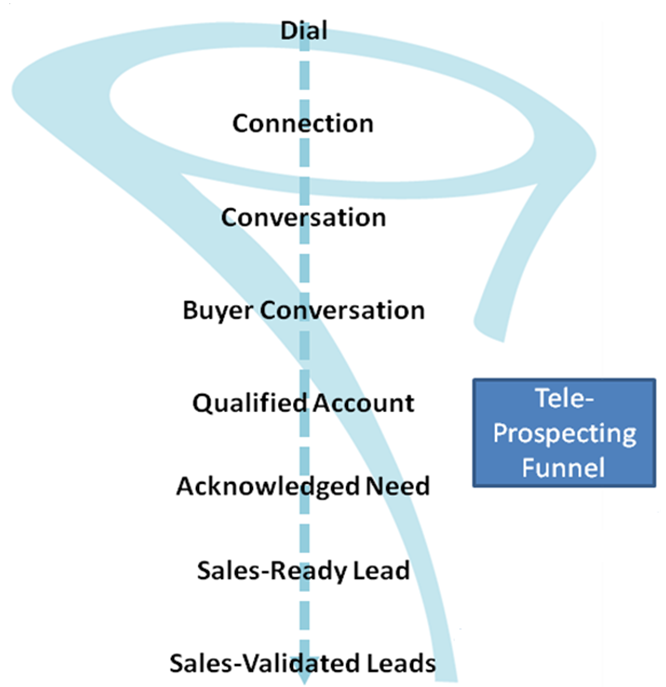Funnel measurements have two important benefits in B2B lead generation:
1. Helping marketers forecast outcomes. By tracking the conversion percentages, marketers can apply those conversion percentages to each new campaign and predict what the outcome will be before the campaign occurs. Such predictions are very helpful in capacity planning and budgeting.
2. Helping marketing identify funnel leakage and optimize revenue production. Marketers can apply both their own internal, historical baseline conversion ratios (i.e., an aggregation of conversion ratios) and industry benchmarks, like those gathered by MarketingSherpa.
Executive-level funnel metrics provide marketers with the 50,000-foot view to provide an end-to-end perspective. But when there appears to be leakage, zooming in on a particular leak is essential.
In that context, let me share seven funnel conversions for teleprospecting.
But first, let’s agree on the scope. In B2B, there are two important functions in this area:
- Following up on, qualifying, educating, and nuturing marketing responses until they are sales-ready leads.
- Prospecting into target accounts to identify and qualify existing demand and to generate demand and convert that demand into sales-ready leads.
For both of these activities, it seems the key funnel stages would be similar. But, what are they?
Before I share a point of view on this important subject, let me say that teleprospecting is very complex and the interpretation of outcomes at various stages of the funnel are more and more subjective. Plus, in one call, the teleprospecting rep may go through all the funnel stages.

Click to enlarge
1. Dial – a teleprospecting rep making an outbound dial; or a customer making an inbound call.
2. Connection – the dial converting into a connection.Those dials that do not convert into connection either have busy-outs, dials with no answers, recorded phone company messages about the number being out of service or changed. A very high percentage of dials not converting into connections means the list or lead source is problematic.
3. Conversation. – the rep reaching someone to have a conversation, however short; a prospect reaching a teleprospecting representative via an inbound call.
4. Decision-maker conversation – some of the conversations are with those who would be part of a decision and some are not, either because the teleprospecting representative is speaking merely to a receptionist or to someone otherwise not involved in the solution area.
Decision-maker/decision-influencer conversations are much more predictive of future purchase intent than non-conversations. Even when following up on marketing responses, it’s not uncommon that 20 percent of more of the leads never make it to this stage.
5. Qualified Account – Usually, the first thing a teleprospecting representative does is qualify the person. The second thing is often qualifying the account. Is the account in the target market? Those that are would get this kind of status.
At the top of the market, the funnel may end here with an attempt to set an appointment, the idea being that the sales person will take meetings with the right people in the right accounts because the buying potential is so large.
6. Acknowledged Need – The next thing a teleprospecting representative does is discover if there are buying plans, and if not, at least an acknowledged need. Those who meet the other criteria (Qualified Account, a stakeholder in the decision processs) and have an acknowledged need are the most likely to convert into a sales-ready lead.
In fact, for some larger accounts, the sales organization may decide that this level of qualification is sufficient to warrant sales follow-up. Others in this stage might warrant tele-nurturing.
7. Sales-Ready Lead. Sales-ready leads meet any other qualifying criteria, like a particular timeline for buying, the existence of a budget, etc.
And then, of couse, the overall sales-marketing funnel extends beyond the teleprospecting operation as sales people validate leads, convert them into opportunities, forecast them, and close them.
There are some problems with the above funnel however:
- It doesn’t account for inbound or outbound emails sent to or from the teleprospecting representative or the clickthroughs that might happen.
- It doesn’t factor in online chat sessions, where there might be an opportunity to identify the prospect, qualify their interest, role, and the account they work for, all before having a live conversation with them.
- There is also nothing in here about leaving messages, per se, like a voice mail.
- There could certainly be other stages, like a presentation stage, where the teleprospecting representative presents, however informally, (via WebEx, DimDim, etc.) some kind of elevator pitch to the prospect.
- It’s also possible that by sending an Outlook meeting request or speaking to an admin, a teleprospect representative schedules a phone meeting.
- Finally, there isn’t a stage for doing some kind of preliminary investigation of an account and/or a contact, like going to LinkedIn or the account website.
Obviously, these limitations speak to the complexity of B2B teleprospecting for the complex sale, and the evolution of this capability to include more and more Web-based tools for both discovery and communication.
What funnel stages do you see as most important?
Related Resources
B2B Lead Generation: Why teleprospecting is a bridge between sales and marketing
B2B Marketing: The FUEL methodology outlined
How and When to Use Content in the B2B Sales Process (Members library)
Free MarketingSherpa B2B Newsletter









